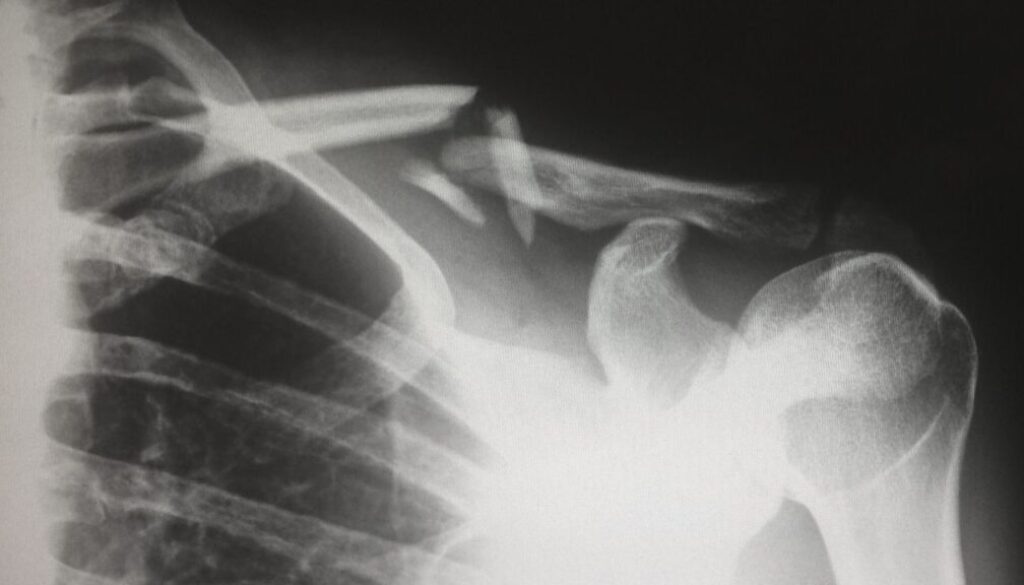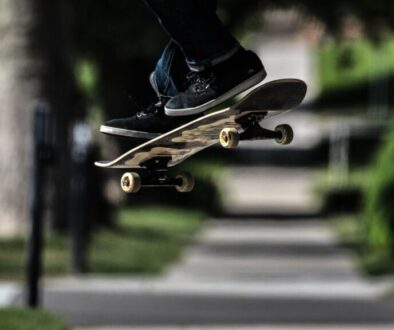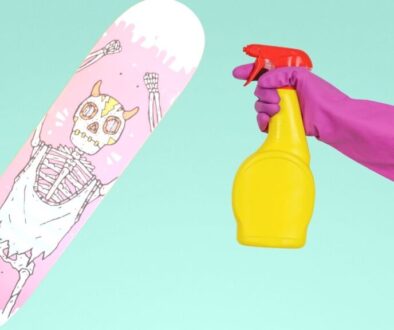Is Skateboarding Dangerous?
Skateboarding is a great way to have fun and an amazing form of exercise. Not to mention the perfect way to get around. But how risky is it? Check out our article on how to keep skateboarding risk down on the HVS Boardsport blog!
For those of us who are passionate about skateboarding, it’s not just a way to get around (although it’s great for that too!). We love it because it’s an amazing sport and a great lifestyle. Plus, it’s an all-around thrilling way to get massive exercise benefits.
As you can imagine, we got a lot of questions about skateboarding here on the HVS Boardsport blog. One of the most common questions is whether skateboarding is dangerous.
The short answer is that, like anything, without the proper care it can be dangerous. But it doesn’t have to be. Using common sense, quality equipment, and avoiding risky behavior helps lower risk. And keeping risk to a minimum is always wise.
On the flip side, skateboarding has lots of advantages. For one thing, it’s a great way to get around. The average skateboard speed is over three times the average walking speed. And skateboarders love the convenience of not having to lock up their board like you would have to with a bike.
So exactly what are the risks of skateboarding, and what can you do to stay safe? We’ve put together several things to keep in mind when it comes to safe skateboarding.
The Risks of Skateboarding
Like any other sport, skateboarding does have its risks. There are injuries, and they can range from moderate to severe. Some of the most common skateboarding injuries include:
- Sprains, strains and fractures to several parts of the body, most often the arms, legs, neck, and trunk
- Injuries to the face, such as a broken nose or fractured jaw
- Concussion and other severe head injuries
Statistics show that 74% of skateboarding injuries involve contusions, sprains, and fractures. The majority of injuries are to the extremities, while 20% of injuries are to the head. Around 3.1% of injuries are serious head injuries such as blunt trauma or even skull fracture. And quite a few results in a concussion. But it’s also worth noting that with the right headgear, most would not have happened.
As with many things, those who are less experienced are often more prone to injury. People who are more experienced have the know-how to avoid certain situations. Statistics show that one-third of injuries occur with less than one weeks’ experience.
When Skateboarding is Riskiest
There are several important factors that can contribute to making skateboarding riskier. One thing to keep in mind is that skateboards give you much less control than you’d have riding a bike. Catching a wheel on a twig or small stone can cause an inexperienced skateboarder to fall.
There are a variety of conditions that can make skateboarding extra risky, such as:
- Skateboarding on rough or wet surfaces
- Failing to wear protective gear
- Skateboarding in or near traffic
- Using homemade ramps
- Skateboarding too fast
- Trying risky stunts
- Drinking while skateboarding
The Average Skateboarder
So who is the average skateboarder? Worldwide, there are more than twenty million skateboarders. Approximately 90% are male, with an average age of 14. While 1/3 of skateboarding injuries in 2015 were skaters between the ages of 5 and 14, half are in the 14-24 age group.
That same year, there were 125 145 skateboard-related emergency room incidents reported.
A word of caution to parents. Allowing young children to skateboard could be risky. There are several reasons why. Skateboarding is not a good sport for children under ten years of age. For one, young kids often have underdeveloped motor coordination. And that can spell disaster on a skateboard.
Statistically, there are several other sports that are more dangerous than skateboarding, including:
- Basketball
- Football
- Hiking
- Horseback riding
- Women’s soccer
But, skateboarding injuries are more frequent and severe than in some sports. Rollerblading or inline skating, for example. It always pays to be cautious.
Kids and Skateboarding
Children also have a tendency to underestimate risk and overestimate their abilities. They often have underdeveloped coordination and slow reaction times. It can all lead to far more accidents than adults and older kids.
While there are fatalities, they’re reasonable when compared with some other sports. In the U.S. an average of 40 people die in skateboarding accidents per year. The most common reason for fatalities is the collision with a motor vehicle. The second most common cause of death while skateboarding is hill bombs.
Young children also have different proportions. Their heads are larger in proportion to their bodies. This means they have a higher center of gravity than adults. Many children are also unable to brace themselves in a fall. It all means that head injuries are far more common in kids under ten.
How to stay safe on a skateboard
So, what are the steps you can take to ensure the safest skateboarding experience? We’ve put together a list of the top six ways to stay safe when skating:
Don’t Just Wing It
Skateboarding can be an interesting thing when you first get started. From staying in control to staying on the board, there are some challenges. Be sure to take your time when you’re first starting out and learn the basic skills you need to stay safe. For example, how to stop. That’s an important one. And do not practise near heavy traffic, or in a crowded area. And always skate in wide and open areas, so if you fall you do not hit anything.
There are also techniques to help you slow down safely, how to turn and how to recover if your balance is wavering. Learning these techniques, along with how to fall, goes a long way toward safe riding. The basic skateboarding skills are best learned slowly, so take you time, concentrate and fokus on safety first.
Use the Right Skateboard
As with anything, you get what you pay for, and when it comes to skateboards, you want quality. There are skateboards designed for different skill levels and different types of riding. For example, skateboards with shorter decks work well for beginners. They tend to balance better, making them easier to handle.
Making sure you have the right skateboard can go a long way toward optimizing safety.
Inspect Your Board
Before riding your skateboard, be sure to check it to make sure everything is in good working order. Watch for any cracks in the wheels or in the board itself, as well as sharp edges or issues with the top surface. Riding a skateboard that needs repair is never wise. Inspecting your board and keeping up on repairs is vital to safety. If you think that your skateboard deck is about to snap, it is best to get a new deck.
Wear the Right Gear
Protective gear is vital to safety. Wearing the right, high-quality gear can prevent a variety of injuries. Always wear:
- Elbow pads
- Helmet
- Knee pads
- Shoes
- Wrist guards
Failing to wear the proper gear is the number one reason for preventable injuries. Be sure to inspect your gear before each use. Make sure it’s intact and replace any pieces that are beginning to wear or break down. Replace safety gear on a regular basis, also. For example, get a new helmet every five years or so. Be sure to read and follow manufacturer’s advice on when to replace your safety equipment.
Use Designated Skateboarding Areas
Professional skateboarding areas are great fun well away from traffic and other dangers. Skateboard parks have special ramps and bowls that make for a great ride while helping to keep you safe.
Know Your Limits
This is perhaps the most important thing to bear in mind, as this is often the one thing that causes a lot of injuries. Tricks are great fun but performing tricks you haven’t worked up to yet can cause serious injury. When learning new tricks, be safe about it. Be sure to take it slow, practice mindful skating and don’t ever extend beyond your current skill level too fast. Improving your performance is part of the thrill of skateboarding. But taking things too quick could be asking for trouble.
Staying safe while on your skateboard is a matter of common sense. Knowing your limits, being safe and taking things slow are some great tips that make sense.
Aside from the tips mentioned above, there are a few other things to keep in mind, such as:
- Never skateboard with two people on a board
- Never use homemade ramps or equipment
- Don’t use headphones while skateboarding
- Always stay aware of your environment
So we’ve covered some of the facts about skateboarding safety. We’ve talked about how to stay safe while riding. Now let’s get into some of the benefits of skateboarding. Skateboarding is amazing fun. Yet you may not realize the vast health benefits it provides.
We’ve put together a section on the benefits of skateboarding!
Why Is Skateboarding Good for You?
All this talk about how skateboarding can be dangerous can be intimidating. But it’s also important to remember that there are so many reasons skateboarding is good for you. It all comes down to the fact that skateboarding is an amazing form of exercise.
Seasoned skateboarders can burn mega calories. And there are a host of other advantages. including:
- Coordination: Being able to maneuver on a skateboard takes a lot of coordinating! Your arms, legs, feet and of course eyes need to work together! And that’s only some of the body parts that come into getting good at this challenging sport!
- Endurance: Skateboarding may be your primary method of transportation. It may be something you do for fun a few hours a week, but either way it takes endurance to perform well.
- Flexibility: Flexibility is a huge part of being able to skate well, especially in the ankles. If your joints are stiff and inflexible, you’ll find you need to loosen up to skate at your full potential.
- Mindfulness: Skating on autopilot is not something we’d recommend. In fact, to stay safe out there you need to be mindful of every move you make, as well as what’s going on in your environment. For this reason, skating can help cultivate mindfulness in a way that few other sports can.
- Stress Relief: This is a big one! Any exercise is a great stress reliever. But there’s nothing quite like focusing on your skateboard to help clear your head. Skateboarding is a great form of stress relief that keeps right on even after you’ve put the board away.
In fact, skateboarding is a full-body aerobic workout that just won’t quit. As with any other exercise, skateboarding lowers risk for diseases such as diabetes. It also helps lower the risk of coronary disease and obesity while keeping you strong and lean.
So while skateboarding can be risky, it definitely has its benefits. Fun is only one of them, although granted it’s a big one.
To stay safe, you need to learn some basic techniques, wear the right gear and stay mindful. Got any thoughts on skateboarding and risk? We’d love to hear them! Let us know what you think in the comments below!



